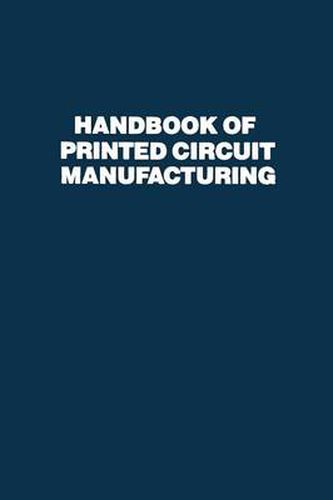Readings Newsletter
Become a Readings Member to make your shopping experience even easier.
Sign in or sign up for free!
You’re not far away from qualifying for FREE standard shipping within Australia
You’ve qualified for FREE standard shipping within Australia
The cart is loading…






This title is printed to order. This book may have been self-published. If so, we cannot guarantee the quality of the content. In the main most books will have gone through the editing process however some may not. We therefore suggest that you be aware of this before ordering this book. If in doubt check either the author or publisher’s details as we are unable to accept any returns unless they are faulty. Please contact us if you have any questions.
Of all the components that go into electronic equipment, the printed circuit probably requires more manufacturing operations-each of which must be per formed by a skilled person-than any other. As a shift supervisor early in my printed circuit career, I had to hire and train personnel for all job functions. The amount of responsibility delegated to my subordinates depended strictly on how well I had been able to train them. Training people can be a trying experience and is always a time-consuming one. It behooved me to help my workers obtain the highest degree of job under standing and skill that they and I were capable of. One hindrance to effective teaching is poor continuity of thought, for example, having to say to a trainee, Wait a minute; forget what I just told you. We have to go back and do some thing else first.
It was in trying to avoid pitfalls such as this that I undertook a detailed examination of the processes involved, what I thought each trainee had to know, and what questions they would most frequently ask. From this analysis I developed the various process procedures. Only after I had done so was I able to train effectively and with the confidence that I was doing the best possible job. Answers had to be at hand for all of their questions and in what ever detail they needed to know.
$9.00 standard shipping within Australia
FREE standard shipping within Australia for orders over $100.00
Express & International shipping calculated at checkout
This title is printed to order. This book may have been self-published. If so, we cannot guarantee the quality of the content. In the main most books will have gone through the editing process however some may not. We therefore suggest that you be aware of this before ordering this book. If in doubt check either the author or publisher’s details as we are unable to accept any returns unless they are faulty. Please contact us if you have any questions.
Of all the components that go into electronic equipment, the printed circuit probably requires more manufacturing operations-each of which must be per formed by a skilled person-than any other. As a shift supervisor early in my printed circuit career, I had to hire and train personnel for all job functions. The amount of responsibility delegated to my subordinates depended strictly on how well I had been able to train them. Training people can be a trying experience and is always a time-consuming one. It behooved me to help my workers obtain the highest degree of job under standing and skill that they and I were capable of. One hindrance to effective teaching is poor continuity of thought, for example, having to say to a trainee, Wait a minute; forget what I just told you. We have to go back and do some thing else first.
It was in trying to avoid pitfalls such as this that I undertook a detailed examination of the processes involved, what I thought each trainee had to know, and what questions they would most frequently ask. From this analysis I developed the various process procedures. Only after I had done so was I able to train effectively and with the confidence that I was doing the best possible job. Answers had to be at hand for all of their questions and in what ever detail they needed to know.